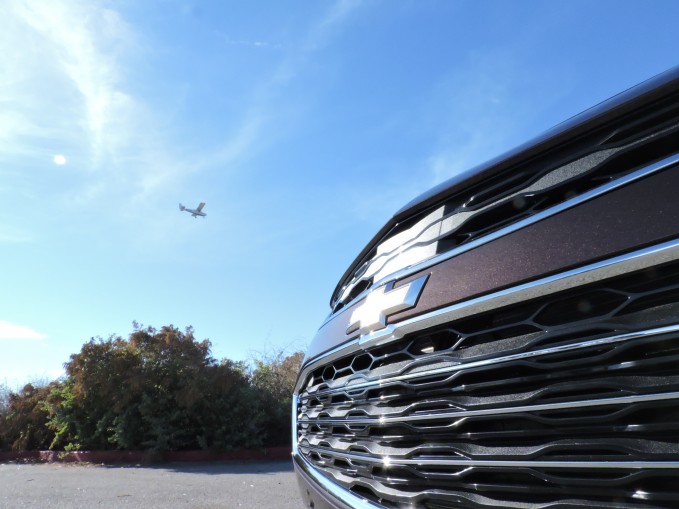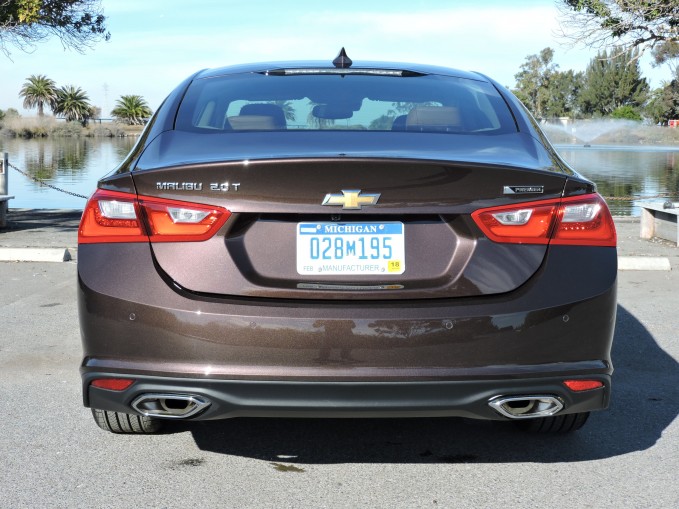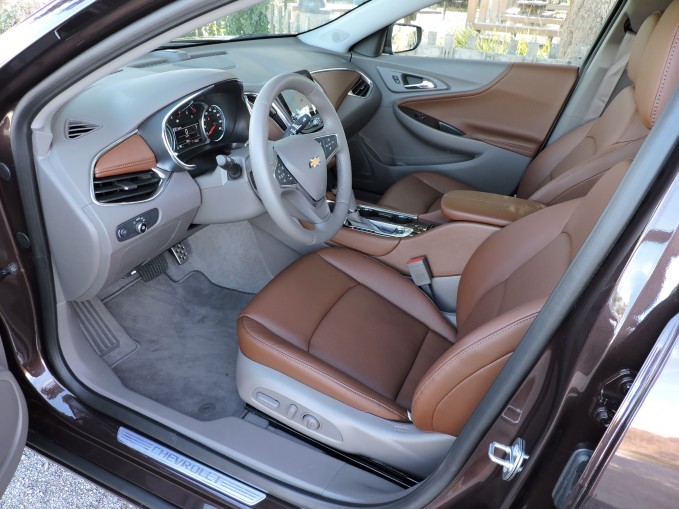The modern day Chevrolet Malibu hasn’t had an easy life.
Reintroduced as a nameplate in 1997, the Malibu was adorned with the unenvious task of battling family sedan heavyweights like the Toyota Camry and Honda Accord. But try as it may, the Malibu always fell a bit short. With each new generation, the Malibu would improve, but so would the competition. In a proverbial game of cat and mouse, the cat never could quite catch those pesky mice.
Chevrolet now has another opportunity to turn the Malibu into a prime-time player. Rebuilt from the ground up, the new car is officially the ninth-generation Malibu, but really the fifth-generation model since the Malibu’s front-wheel drive rebirth nearly 20 years ago.
ALSO SEE: 2015 Toyota Camry vs. 2015 Honda Accord
Lighter and Sexier
One look at the 2016 model, and it’s obvious the Malibu is a new car; a sexy new car at that. Gone are the awkward quad tail lights, replaced by a rear end that is heavily influenced by the larger Impala. Up front is Chevrolet’s new design language that somehow looks aggressive, conservative and upscale all at the same time.
The new car is larger than the outgoing model, measuring 193.8 inches in total length. That makes it slightly longer than Camry, Accord or Ford Fusion. But being a bigger car does not mean it’s a portly one. Due to some clever engineering, the new Malibu has shed a lot of weight. Base models now tip the scales at an incredible 3,086 pounds. That’s lighter than the Camry and Accord and about 350 pounds lighter than a base Ford Fusion. Fully loaded, the Malibu still only weighs 3,388 lbs. For reference, Chevrolet’s smaller Cruze can weigh as much as 3,474 lbs when equipped with the diesel engine.
Taking advantage of the lightened Malibu are three drivetrain options. Standard in the Malibu is a 1.5-liter turbocharged four-cylinder engine that makes 160 horsepower and 184 pound-feet of torque on regular pump gas. Next up is a hybrid drivetrain that we will cover in depth in a future review. Topping the range is a 2.0-liter turbocharged four-cylinder engine that makes 250 hp and 258 lb-ft of torque.
Would You Like a Small Turbo?
Looking at the specs, you may notice that the 1.5-liter engine is down on power compared to a lot of its competitor’s base engines. While this is true, the torque figures are right on par and, for the most part, delivered at lower rpms.
The 1.5-liter engine comes paired exclusively to a six-speed automatic transmission. From a dead stop, the small turbo pulls the Malibu with surprising vigor, but once underway, the 1.5-liter engine behaves similarly to most other mid-size sedans base engines.
SEE ALSO: 2016 Chevrolet Malibu Video – First Look
Due to its bias towards low-end power, the 1.5-liter shifts well before redline even under full throttle. A driver can force it to redline by using the manual shift toggle on top of the gear lever if inclined.
But this engine is more focused on efficiency than outright speed. Small engine displacement and a relatively lightweight vehicle add up to some impressive fuel economy numbers. The 2016 Malibu with the 1.5L turbo drivetrain is officially rated at 27 mpg city and 37 mpg highway. While that doesn’t quite match the base Nissan Altima, it does tie the Accord and beat the most efficient versions of the non-hybrid Camry and Fusion.
Or Maybe You Would Like a Big Turbo?
But not everyone is after efficiency. Some want power. And for them, there’s an available 2.0-liter turbocharged engine that generates 250 hp and 258 lb-ft of torque. Again, these figures fall a bit short of the Malibu’s competitors, but the mid-sized Chevy has a trick up its sleeve in addition to a low curb weight.
Paired exclusively to the larger turbocharged engine is a new eight-speed automatic transmission. Chevrolet says this is the first use of an eight-speed automatic in a front-wheel-drive application for North America, glossing over the fact there is already a nine-speed auto in use – even if that transmission is quite terrible.
Refinement Rules Over Sport
Despite the larger amount of ponies and gears at the driver’s disposal, there are no sport modes of any sort for the Malibu. Think of this larger engine as a premium thrust upgrade over a sporty enhancement, because the refinement levels in the Malibu’s drivetrain are quite unexpected.
The new car is eerily quiet, especially on the freeway. As speeds approach 75 mph, the Malibu remains as quiet as it did while traversing the city at 25 mph. The only noises that do make their way into the cabin are a faint tire hum and some engine noise. Under full throttle, neither engine sounds all that pleasing, but the engines never gets thrashy or obtrusive even though it is decisively quick.
SEE ALSO: How GM Engineered a Lighter Malibu
The 2016 Malibu can be had with wheels ranging from 16 to 19 inches in diameter. The 18 and 19 inch wheel options come wrapped in wide, 245-mm rubber. Again, despite the performance orientated tire size, the Malibu is built more for comfort and refinement than sport. The chassis is well set up, offering a soft ride while still controlling body motions and minimizing roll through the corners. The steering is surprisingly communicative for a family sedan and the car has an overall premium driving feel.
Almost There
But there is a letdown – the interior. Chevrolet’s measures to keep the Malibu’s price in check are a bit too evident in some areas. Despite a clean overall design, some materials used in key areas leave a bit to be desired. The bottoms of the doors are finished in an easily scratchable, dated plastic material that will show signs of wear in no time. In lower to mid-trim Malibus, this same material adorns the top of the doors as well as various parts of the center console. For how refined and sophisticated the 2016 Malibu is in terms of exterior appearance and driving behavior, it’s a shame the interior quality can’t match up.
Chevy fixed one of the outgoing Malibu’s issues by offering more rear seat space. Now offering 38.1 inches of rear legroom, the new car is pretty much on par with its key competitors. Headroom, although a bit tight, is acceptable even if the roof wraps around the sides a bit too much for taller passengers.
The Malibu’s interior quality may be a bit lacking, but the level of technology available inside the car is most definitely not. Apple CarPlay, Android Auto and 4G LTE WiFi can all be equipped, as well as safety features like active lane keep, adaptive cruise control and rear cross traffic alert.
The most interesting piece of technology in the 2016 Malibu, though, is the Teen Driver feature. Designed for parents whose teenage children will be borrowing the car, when activated, the Teen Driver feature mutes out the radio if either front seat belt is unbuckled when passengers are detected up front. As well, there are programmable speed warnings, a radio volume limit and in-vehicle reports for the parents to review on the maximum speed achieved, number of over-speed warnings issued, total distance driven and how many collision alerts were activated while their kids were driving the car. Thank god I’m not a teenager today…
The Verdict: 2016 Chevrolet Malibu Review
For 2016, the base Malibu L begins at $22,500 after destination charges. Fully loaded models come in at $31,795 and are now referred to as Premier, instead of the previous LTZ moniker.
At those prices, the 2016 Malibu is competitively positioned and should bode well for Chevrolet. Sophisticated, refined and efficient, the 2016 Malibu is a minor interior upgrade away from being a potentially overwhelming threat to the stalwarts of the family sedan world. As it stands now, they better still watch their backs – the Malibu is coming.
Discuss this story on our Chevrolet Malibu Forum














